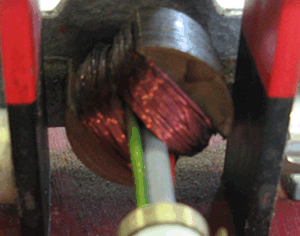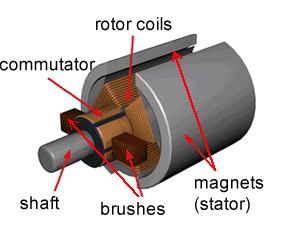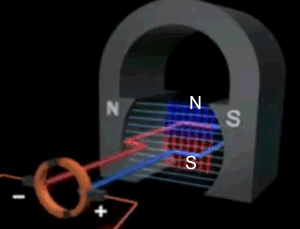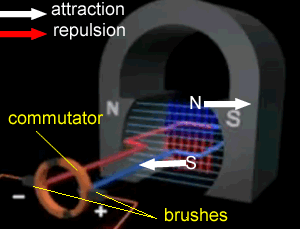
An electric motor is composed of the following:
- Two permanent magnets, which form the stationary part of the motor, known as the stator.
- A commutator is a split ring which changes the polarity of the electromagnets, known as the rotor coils.
- Brushes that conduct a current from the power sources to the commutator.
- Rotor coils which are windings of insulated copper wire that act as electromagnets when a current flows through them.
The shaft, commutator and the windings all form the armature.

The operation of the commutator is shown on the right. Notice how it changes the direction of the current flowing through the coil.
When a rectangular coil carrying current is placed in a magnetic field, as shown on the right, a torque (rotating force) acts on the coil at right angles which rotates the coil as long as current continues to flow through the coil.


The brushes make contact with the commutator and facilitate the flow of current through the windings of wire on the armature. The contact between the commutator and the brushes is a source of friction that must be overcome.
The commutator, acts to reverse the polarity of the magnetic field created by the electromagnet formed as current flows through the windings on the armature. When the plane of the rotating coil of wire reaches a certain position, the brushes break contact. The angular momentum of the coil carries it past this break point and the current then flows in the opposite direction, which reverses the magnetic pole. Note the poles on the electromagnet, shown on the right, as they reverse. Electromagnetic forces of attraction and repulsion drive the rotor and hence determine the magnitude of the torque produced by the motor.
The strength of these magnetic forces determines the speed at which the motor spins. The strength of the magnetic force experienced by the wires that make up the rotor, is determined by the amount of current in the wire, the length of the wire and the size of the magnetic field. It is possible, therefore, to increase the size of the force and thus the speed at which the motor turns by:
• Increasing the number of loops of wire, on the rotor, carrying a current
• Increasing the current flowing through the wire by using a bigger battery or by using wire with less resistance
• Increasing the size of the magnetic field by using a greater number of magnets or by simply using stronger magnets.

What is a purpose of the commutator?